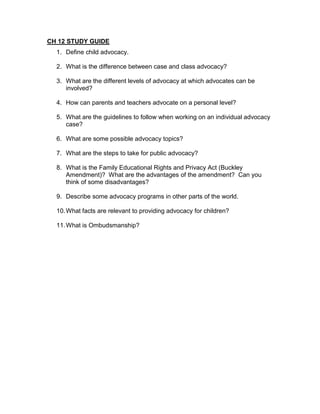
Ch12studyguide460
- 1. CH 12 STUDY GUIDE 1. Define child advocacy. 2. What is the difference between case and class advocacy? 3. What are the different levels of advocacy at which advocates can be involved? 4. How can parents and teachers advocate on a personal level? 5. What are the guidelines to follow when working on an individual advocacy case? 6. What are some possible advocacy topics? 7. What are the steps to take for public advocacy? 8. What is the Family Educational Rights and Privacy Act (Buckley Amendment)? What are the advantages of the amendment? Can you think of some disadvantages? 9. Describe some advocacy programs in other parts of the world. 10. What facts are relevant to providing advocacy for children? 11. What is Ombudsmanship?
